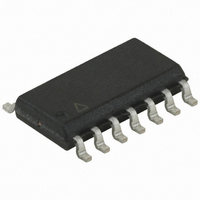ATTINY24A-SSU Atmel, ATTINY24A-SSU Datasheet - Page 117

ATTINY24A-SSU
Manufacturer Part Number
ATTINY24A-SSU
Description
MCU AVR 2K FLASH 20MHZ 14SOIC
Manufacturer
Atmel
Series
AVR® ATtinyr
Specifications of ATTINY24A-SSU
Core Processor
AVR
Core Size
8-Bit
Speed
20MHz
Connectivity
USI
Peripherals
Brown-out Detect/Reset, POR, PWM, Temp Sensor, WDT
Number Of I /o
12
Program Memory Size
2KB (1K x 16)
Program Memory Type
FLASH
Eeprom Size
128 x 8
Ram Size
128 x 8
Voltage - Supply (vcc/vdd)
1.8 V ~ 5.5 V
Data Converters
A/D 8x10b
Oscillator Type
Internal
Operating Temperature
-40°C ~ 85°C
Package / Case
14-SOIC (3.9mm Width), 14-SOL
Processor Series
ATTINY2x
Core
AVR8
Data Bus Width
8 bit
Data Ram Size
128 B
Interface Type
SPI, USI
Maximum Clock Frequency
20 MHz
Number Of Programmable I/os
12
Number Of Timers
2
Maximum Operating Temperature
+ 85 C
Mounting Style
SMD/SMT
3rd Party Development Tools
EWAVR, EWAVR-BL
Development Tools By Supplier
ATAVRDRAGON, ATSTK500, ATSTK600, ATAVRISP2, ATAVRONEKIT
Minimum Operating Temperature
- 40 C
On-chip Adc
10 bit, 20 Channel
For Use With
ATSTK505 - ADAPTER KIT FOR 14PIN AVR MCU
Lead Free Status / RoHS Status
Lead free / RoHS Compliant
Available stocks
Company
Part Number
Manufacturer
Quantity
Price
Company:
Part Number:
ATTINY24A-SSU
Manufacturer:
ATMEL
Quantity:
3 100
Company:
Part Number:
ATTINY24A-SSU
Manufacturer:
ATMEL
Quantity:
15 000
Part Number:
ATTINY24A-SSU
Manufacturer:
MICROCHIP/微芯
Quantity:
20 000
Part Number:
ATTINY24A-SSUR
Manufacturer:
ATMEL/爱特梅尔
Quantity:
20 000
- Current page: 117 of 286
- Download datasheet (10Mb)
14.3
14.3.1
8183C–AVR–03/11
Functional Descriptions
Three-wire Mode
The 4-bit counter can be both read and written via the data bus, and it can generate an overflow
interrupt. Both the USI Data Register and the counter are clocked simultaneously by the same
clock source. This allows the counter to count the number of bits received or transmitted and
generate an interrupt when the transfer is complete. Note that when an external clock source is
selected the counter counts both clock edges. This means the counter registers the number of
clock edges and not the number of data bits. The clock can be selected from three different
sources: The USCK pin, Timer/Counter0 Compare Match or from software.
The two-wire clock control unit can be configured to generate an interrupt when a start condition
has been detected on the two-wire bus. It can also be set to generate wait states by holding the
clock pin low after a start condition is detected, or after the counter overflows.
The USI Three-wire mode is compliant to the Serial Peripheral Interface (SPI) mode 0 and 1, but
does not have the slave select (SS) pin functionality. However, this feature can be implemented
in software if necessary. Pin names used by this mode are: DI, DO, and USCK.
Figure 14-2.
Figure 14-2
The two USI Data Registers are interconnected in such way that after eight USCK clocks, the
data in each register has been interchanged. The same clock also increments the USI’s 4-bit
counter. The Counter Overflow (interrupt) Flag, or USIOIF, can therefore be used to determine
when a transfer is completed. The clock is generated by the Master device software by toggling
the USCK pin via the PORTA register or by writing a one to bit USITC bit in USICR.
SLAVE
MASTER
Bit7
Bit7
shows two USI units operating in three-wire mode, one as Master and one as Slave.
Bit6
Bit6
Three-wire Mode Operation, Simplified Diagram
Bit5
Bit5
Bit4
Bit4
Bit3
Bit3
Bit2
Bit2
Bit1
Bit1
Bit0
Bit0
PORTxn
ATtiny24A/44A/84A
USCK
USCK
DO
DO
DI
DI
117
Related parts for ATTINY24A-SSU
Image
Part Number
Description
Manufacturer
Datasheet
Request
R

Part Number:
Description:
Manufacturer:
Atmel Corporation
Datasheet:

Part Number:
Description:
Manufacturer:
Atmel Corporation
Datasheet:

Part Number:
Description:
IC MCU AVR 2K FLASH 20MHZ 20-QFN
Manufacturer:
Atmel
Datasheet:

Part Number:
Description:
IC MCU AVR 2K FLASH 20MHZ 14SOIC
Manufacturer:
Atmel
Datasheet:

Part Number:
Description:
MCU AVR 2K FLASH 15MHZ 20-QFN
Manufacturer:
Atmel
Datasheet:

Part Number:
Description:
IC MCU AVR 2K FLASH 20MHZ 14-DIP
Manufacturer:
Atmel
Datasheet:

Part Number:
Description:
MCU AVR 2KB FLASH 20MHZ 14SOIC
Manufacturer:
Atmel
Datasheet:

Part Number:
Description:
MCU AVR 2KB FLASH 20MHZ 20QFN
Manufacturer:
Atmel
Datasheet:

Part Number:
Description:
MCU AVR 2K FLASH 15MHZ 14-SOIC
Manufacturer:
Atmel
Datasheet:

Part Number:
Description:
DEV KIT FOR AVR/AVR32
Manufacturer:
Atmel
Datasheet:

Part Number:
Description:
INTERVAL AND WIPE/WASH WIPER CONTROL IC WITH DELAY
Manufacturer:
ATMEL Corporation
Datasheet:

Part Number:
Description:
Low-Voltage Voice-Switched IC for Hands-Free Operation
Manufacturer:
ATMEL Corporation
Datasheet:











